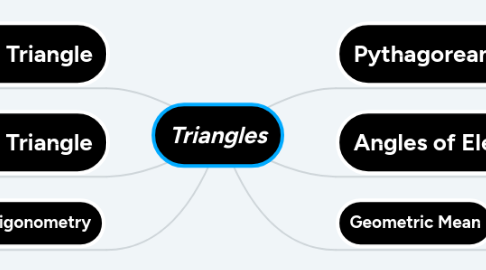Triangles
作者:Joshua Esteban

1. 30-60-90 Right Triangle
1.1. -Use when dealing with a 30-60-90 triangle. Identify the hypotenuse, shorter leg, and longer leg. The shorter leg is always opposite the 30 degree angle.
1.2. -If given a length for any side, use this to find the value of the variable. The hypotenuse equals 2x, shorter leg equals x, while the longer leg equals x multiplied by the square root of 3.
1.3. Formulas: Shorter Leg: X Longer Leg: x√3 Hypotenuse: 2x
2. 45-45-90 Right Triangle
2.1. -Use when dealing with a 45/45/90 triangle. When finding the measure of one leg, identify if it is opposite a 45 degree angle or a 90 degree angle. This triangle is always an isosceles triangle with a hypotenuse and two similar legs.
2.2. In order to solve for the missing lengths, use the formulas.
2.3. The two similar legs equal x while the hypotenuse equals x multiplied by the square root of 2.
3. Trigonometry
3.1. -Use this method in order to find missing angles and side lengths. Identify what is given to you and use it in order to find side lengths and angles.
3.2. -Use the three trigonometric ratios: Tangent, Cosine, and Sine
3.3. -If given the hypotenuse and opposite, use sine. Opposite on top while hypotenuse is on the bottom. If given the adjacent measure and hypotenuse use cosine. Adjacent on top while hypotenuse is on the bottom. For tangent, opposite is on top while adjacent is on the bottom.
4. Pythagorean Theorem
4.1. -Use only when working on a right triangle
4.2. -Can be used when asked to solve for a missing side length
4.3. a^2 + b^2 = c^2 C represents the hypotenuse while A and B represent the 2 side lengths
5. Angles of Elevation/Depression
5.1. -This is used when trying to find the angle of elevation/depression relative to a specific object.
5.2. -In order to find the angle of elevation/depression, find the distance of the two object from one another as well as the height of the objects. Depending on whats given, use tangent, cosine, or sine.
5.3. -Use the inverse of sine, cosine, or tangent when given the required measures. In order to use the inverse of these trigonometric ratios, set up the ratios correctly and solve for the angle of elevation/depression by multiplying the numerator by the inverse and dividing by the denominator.
6. Geometric Mean
6.1. -When dealing with an oblique triangle, use the geometric mean formulas in order to find missing lengths and angle.
6.2. -When the triangle is split and made into multiple right triangles, use the altitude in order to solve. Use corollary 1. The geometric mean is the product of segment 1 and 2 of the hypotenuse. Seg1/Altitude=Altitude/Seg2 Solve for Altitude
6.3. -When solving for the two legs, use corollary 2. Seg1/Leg1=Leg1/Hypotenuse Solve for Leg 1


